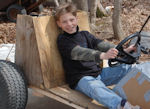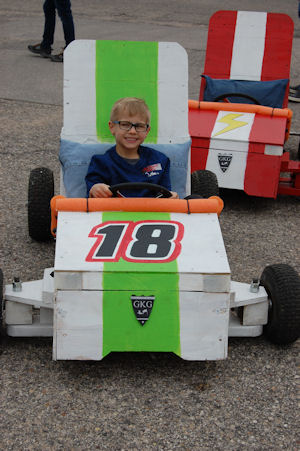n my adventures over the years I have fallen into the trap of putting pressure on myself to make go karts out of junk, out of old tractors, old vertical engines, out of wood….this list goes on. I am a little special in that I try to put myself into the shoes of the guy who has nothing, but wants to have some fun with the junk he has sitting around.
There is a two prong approach to this effort in my mind. I want to get that gokart running and for cheap, but I also want to teach and help others understand the principals behind mechanisms, engines, and vehicle dynamics.
That being said, there are ten things that I had to discover for myself and as hindsight is always 20/20 I am relaying them to you here….
Tip #1
To start the list off, the drive line is so important. Not having the right driveline is like having a Porsche 911 that is pedal powered. It can be the most exasperating and exhausting elements of the gokart if not designed properly. You may have an awesome running engine but a gokart that just smokes the clutch and doesn’t go anywhere.
If I were to tally up the complaints on go karts it would be the drive system. For example on our Wooden GoKart, the Phi Alpha 20 we did our due diligence in the beginning on the drive line. We had limited components, but with the calculations program included in with How To Build A Go Kart 203 book we designed our driveline exactly as the program told us, and came up with an awesome accelerating machine that can climb hills and bop around yards.
The vertical engine drive system falls into the same category, though it is a bit different, it too can be tuned to fit optimum hill climbing conditions. That is why we include our vertical engines drive course (Go Kart Building 202) with all our bundles, because we know the importance of getting the drive line right.
I’ll let you in a little secret, there is no ONE SIZE fits all drive line, each one needs to be tailored to your go kart, and the Go Kart Building 201, 202, and 203 courses explain how drive lines work and how to get the optimum out of it.
Tip #2
Often I am stuck with time constraints and the balance between what I can scrounge, what I can make , and what I should buy. The answer to that question is first what do you have that you can use on a gokart? You may have a 30000 foot level understanding. For example you have a riding lawnmower and you know you could probably use the wheels, the steering wheel, the engine etc.. But the hard question to ask yourself is: How can you use the wheel and hub on a go kart?
Another prime example of using stuff off of a lawnmower is using the rear wheels and tires. They are fantastically huge and have plenty of wear left. But the conundrum comes into mating that wheel with an axel. How is it possible to get a 1 inch live axel to drive a .750 inch diameter hub? If you study our blog article on hub-axel transformation you can get that answer. The point I am making is, do you know how to do it? If you do not, or you have come to the conclusion it is not possible to do, then that answers your purchasing question: you will have to buy rims and tires.
There are a host of other items on the go kart that require that decision, can I use it? Or do I need to buy it. I have developed whole go karts and in the end I have come to the conclusion, perhaps I should have bought that part.
This is a small list of parts that if you are not mechanically inclined or don’t have the ambition to fabricate stuff that you should buy:
- Front Steering Knuckle Assemblies
- Rod Ends and Rod Stock for the steering
- Pedals
- Rear Axel
- Rear Bearings
- Brake Caliper
- Brake Disc
- Rod
- Steering Wheel (yes I said steering wheel, unless you know how to mate a tractor steering wheel to a splined shaft system….stay clear and buy a simple steering wheel.)
- Rear Drive Sprocket
- Clutch
Tip #3
After you have made that list of stuff to buy, then you will complain, “Well golly that is expensive! I was hoping to spend less.” That is where you need to have tallied up that list before you start buying stuff.
That’s right; I said make a list. Tally up the list, and here is the hard part…walk away and think about it for a day or two. Then come back and start weighing the list. Do you have some of the things in the list above that you could perhaps not buy, like rear wheels and hubs? How much could you save by not buying that stuff?
In my opinion, you can make a seat, you can make a frame, you can make a decent steering system. Are you willing to make it, or are you stuck on buying it?
Tip #4
Stopping a go kart is actually quite important, especially when the chain link fence is showing its mean acing existence. Stopping the go kart there is not enough that can be said about it. So if stopping the go kart is so important then why is it the last thing we think about when we design and built our go kart?
The best and most sure stopping power is to have both rear wheels have brakes. The simplest system is the live axel, where a brake disc can be mounted easily and the brake caliper mounted to the frame.
Tip #5
When turning the steering wheel the last thing you want to have happen is that the front wheels continue to go straight. We call that severe understeer. You want good steering response, and the center of gravity is the answer to this problem. Getting enough weight on the front wheels is the problem and positioning of the front wheels is the key to solving this problem. We offer as a free download the center of gravity spreadsheet which allows you to calculate the center of gravity before you develop your gokart design. We used the spreadsheet on all of our go kart designs with success.
Tip #6
When you have the go kart all completed and it drives like a dream, it is tough to share it, because it only has one rider. Because the go kart that was developed for a larger person, such as an adult, the smaller “eager-to-have-a-thrill-rider” misses out because the go kart only seats one person safely.
So the bottom line is consider the number of riders as one of your top priorities when you develop a go kart. This decision will affect the drive system drastically, because now the 5 horsepower engine may now need to be an 8 horsepower, or at least the drive line will need to be tailored to a 5 horsepower so that you still get the thrills.
Also the brake system needs to be upgraded to handle the extra load.
If you haven’t guessed yet but are now figuring it out, it takes some thought when building a go kart and not wanting to bust your budget.
Tip # 7
The glossy eyed go kart lover may want to cut corners and try to use anything available like bike tires or solid style tires used on push mowers. Stop! No you cannot use these wheels safely, the power and the demands of go karting will destroy them. Likewise don’t be fooled into thinking that the Chinese knock- off- 5-dollar wheels and rims are going to last. They might last an outing, but the bearings might be toast after that. Also the rubber specked out in these tires is so totally cheap that they will wear through in minutes. A high quality rubber tire and rim is needed.
Tip #8
I have run into this brick wall a couple of times: bearings. More specifically, front wheel bearings. The wheel bearings (or even bushings) that are on tractor tires or cheap rims will have ¾” diameter bearings. These cheap bearings cannot take a large amount of load before they literally eat through the casing and then fall apart.
Be very leery of these cheap pressed bearings. You need industrial grade radial sealed bearings. The problem is that the inside of the hub will only mate up with a 5/8” roller bearing. To remedy this problem either the steering knuckles that you just purchased need to be modified so that they can take 5/8” bearings, or you need to fabricate your own.
Careful purchasing of steering knuckles with the 5/8” diameter shafts is required, or you will need to modify the steering knuckles that you just purchased and weld on a grade 8 bolt to replace the steering knuckle bolt.
Tip #9
When constructing a steering system it is important to take into account the amount of steering effort that may be required to turn the steering wheel. You may be surprised when you start putting camber and castor into your system the amount of effort required to turn the steering wheel. The reason for this is that the camber and caster put the front wheels at angles which in effect cause the steering to leverage or lift the gokart into the air. This added amount of leverage can be quite a problem when trying to turn the wheels. Be aware of these consequences.
For simplicities sake and for the sake of steering ease, you may want to nix the camber and caster, seeing it is just a go kart, not a Ferrari and a Lamborghini. If you are not willing to nix the camber and caster you may have to make a ratio reduction into your steering system to make the steering easier to turn.
Additionally, when making a two seater gokart the steering forces increase because of the weight. Make sure all the steering linkages move well when a load is applied. What can fool you is when you have the go kart on the stand and all appears to turn and move well, but when the go kart is put on the ground all the tire and friction forces come to bear.
To minimize friction make sure all surfaces are lubed well and that the contact surface between the steering knuckles and the channel housing are not binding but have minimal slippage.
Tip #10
Don’t be surprise with all you busy schedules if the go kart does not get completed in a summer. You really have to have a game plan or as I call it a Realistic Gokart Building Schedule. We offer as a free download the building schedule in our download section.
Realistically if you have your act together you should be able to get a ready and running go kart in 7 weekends.
These Ten tips are by no means exhausting but they do help with the major road blocks to go kart building.
Be sure to stop by our downloads page or sign up for our free newsletter to get access to our downloads page. The downloads have products that are a great help for accessing your center of gravity and basic stress calculations.


